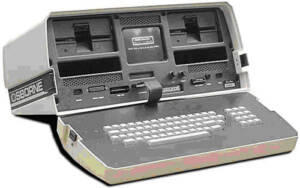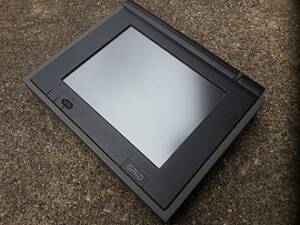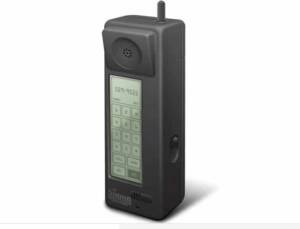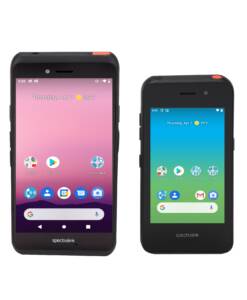Looking Back to See What’s Ahead: The History and Future of the Mobile Computer

It is often said that “hindsight is 20/20,” meaning that looking at the results of past events provides insight into how they could have been different (better or worse) if alternate actions had been taken. The idea of looking at history to predict the future is not new, yet it is something often overlooked in business planning. It stands to reason, then, that examining the history of mobile computing, its users, and use cases can help to provide a prediction of its future.
Mobile Computing: An Origin Story

Osborne 1
Mobile computing originated in the 1980s. While it could be argued that Xerox and RadioShack came up with the first concepts, and even a few Apple execs were rumored to have pitched a design that was ultimately shut down1, it is Adam Osborne and his Osborne company most often credited with producing the first mobile computer in 1981. The Osborne 1 weighed in at 24 pounds, and by today’s standards, we wouldn’t exactly call this mobile, but considering at that point computers were still very large deskbound objects, this was an impressive invention.2
Throughout the 1980s, many other companies like Epson, Kyocera, and Commodore entered the mobile computing space with

GriDPad
variations on rudimentary laptops, though the first device to label itself as a “laptop,” and coincidentally feature the first touchscreen, was the Gavilan SC in 1984.3 While laptop computers continued to evolve, 1989 saw the introduction of the first mobile tablet device, the GriDPad. The GriDPad featured a touchscreen and was the first to use a stylus that could even use handwriting recognition software, and was the inspiration for the design of the first PalmPilot from designer Jeff Hawkins.4
With Intel’s 1990 release of its 20MHz 386SL processor, which was specifically designed for mobile computing due to its battery-saving sleep mode and power management features, the mobile computing landscape truly began to change, and technology began to catch up with the vision. More and more companies started pushing the envelope with mobile computing technology, leading to increased competition that quickened the pace of innovation. And while Apple did release the first PDA (personal digital assistant) in 1993, IBM soon followed with what is considered the first true “smart” phone.

IBM Simon
IBM’s Simon, released in 1994, could perform the same functionality as a PDA while also serving as a fax machine and mobile telephone. Big, bulky, and looking like the early cell phone we all associate with Zack Morris in Saved by the Bell, the Simon included 11 built-in programs, including a to-do list, calendar, calculator, appointment scheduler, electronic sketch pad, world time clock, input screen keyboards, handwritten annotations, and address book, making it truly multi-featured in one device.4 Throughout the late 1990s, these devices started to streamline in design and addressed issues of battery life, screen clarity, memory, processor speed, and weight, while also becoming cheaper, selling for about $1,500. In 2000, Microsoft would release its first “Pocket PC,” and many others like Casio, Compaq, and HP would quickly follow suit.
Enterprise Makes a Case for Mobile Technology
Over the next 15 years, mobile computing and telephony technology continued to evolve. The retail industry was one of the first to adopt mobile computers to improve business workflows and communications for its associates to automate grocery stores ordering and inventory processes. These devices were sold to business users like retail stores to improve worker productivity by eliminating paper forms, reducing input errors, and automating traditionally manual tasks. These devices were “tools” for the “task worker” and were often shared amongst the staff who needed to be mobile during their shifts instead of tied to a desk with a landline or laptop.
As the devices gained functionality and new workflows were developed, the use case for business expanded to include distribution, manufacturing, transportation, and healthcare. This new functionality included faster processors, improved form factors, ruggedization, and the development of wireless networks to improve user productivity. Many of these technologies made their way into consumer products. For example, the Wi-Fi network we use today was invented by mobile computer manufacturers.
In 2007, Apple released its first iPhone, and Google would quickly follow with the Android operating system. The first Android-based phone, Motorola’s Droid, entered the scene in 2009, with over 1 million devices sold in a little over two months. The onset of iPhone and Android truly began the evolution of the consumer smartphone that almost everyone carries in their pocket today. These devices have become our lifeline, our source of information and entertainment, and how we connect with each other and the world. But what would this mean for the enterprise world? How would it translate to meet the unique needs of business instead of the personal needs of the individual?
In the mobile computing world, there were initial thoughts that these consumer smartphones and “Bring Your Own Device” (BYOD) policies in the workplace could be the all-in-one solution businesses were searching for to make their employees’ lives easier, streamline workflows, and improve communication and collaboration. However, the consumer smartphone lacked many business-specific requirements, such as ruggedization, barcode scanning, and separately chargeable batteries to cover the power requirements of extended use cases. Also, corporate security concerns and the requirement to support multiple operating systems limited consumer smartphones’ practicality for many IT organizations.
Mobile computing manufacturers responded by taking the best features and technologies from smartphones and surrounded them with the essential business features of the mobile computer. The enterprise smartphone is much more than its mobile computer predecessor, and enterprises need to think of it as more than a tool for task workers while still acknowledging that it is so much more than a phone. Like the smartphone became the center of each consumer’s world, the enterprise smartphone has the same ability to become the mobile workers’ single tool to accomplish the many activities they perform during each day.
Examples of today’s functionality include:
- Timekeeping
- Internal communications (voice, text, UCaaS)
- External communications (customers, vendors
- Video training
- Personal safety monitoring
- Facility safety alerting
- Task management
- Business-specific workflows that are unique for each market
Retail Examples:
- Curb Side Pickup
- Cycle Counts
- Shelf Price Audit
- Mark Downs
- Product Ordering
- Product Transfers
- Shelf Price Audit
Healthcare Examples:
- Electronic Health Record integration
- Patient/Bed Alarms and Alerts
- Real-time coordination of care amongst entire care teams
- Medicine and patient barcode scanning
- RTLS for hospital assets
- Wound assessments
- Telehealth
What The Past Means for the Future

Spectralink’s Versity 95 and 92 enterprise smartphones
Looking back, we see how consumer smartphones influenced the mobile computing product roadmap and how the popularity of consumer mobile applications has influenced the design of business applications. The next logical transition is providing deskless workers the same opportunity to leverage the benefits that enterprise smartphones provide throughout their workday. The time has arrived where the mobile worker is trading in their wireless telephone, mobile computer, handheld scanner gun, and walkie-talkie for a single device that does it all.
At Spectralink, we not only see the future, but we are also delivering it. For more information on our Versity Family of enterprise smartphones, please visit www.spectralink.com
Sources:
